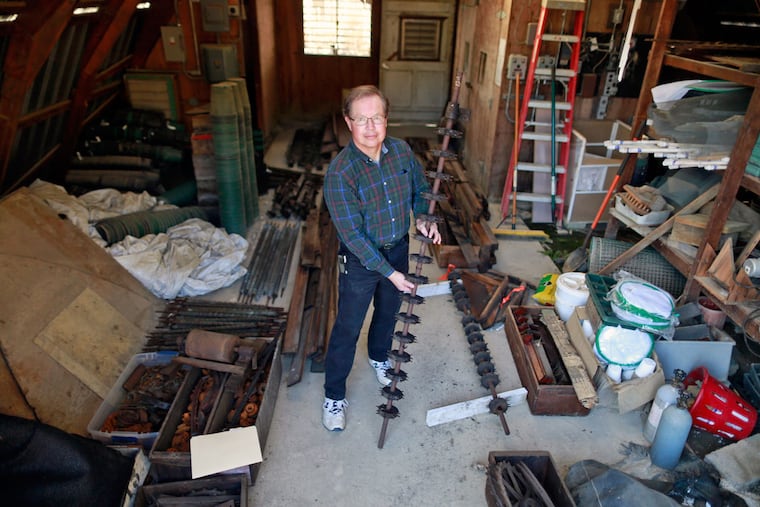The soul of an old machine
Cedar channels, iron drive shafts, brass tappers, and assorted gears, plates, and pulleys were scattered all over the attic of a cranberry-sorting house at the Birches Farm in Tabernacle.

Cedar channels, iron drive shafts, brass tappers, and assorted gears, plates, and pulleys were scattered all over the attic of a cranberry-sorting house at the Birches Farm in Tabernacle.
But Mark Ehlenfeldt knew what to look for.
He'd been studying photographs, schematic diagrams, and patent drawings of a South Jersey invention he hopes to rebuild: an ingenious, if somewhat high-maintenance, cranberry sorter (or separator).
Last seen in operation sometime around 1960 at the Birches, the machine no longer exists - except as hundreds of large and small parts Ehlenfeldt recovered from the attic in October and November.
"It's a piece of agricultural heritage, a piece of history, and it's in danger of being lost," explains Ehlenfeldt, a research geneticist at the P.E. Marucci Center for Blueberry and Cranberry Research.
The agricultural experiment station - operated by the Rutgers Cooperative Extension in Chatsworth, Burlington County - is where I meet Ehlenfeldt, whose main business is studying blueberries.
But the 62-year-old Tabernacle resident has long been active with the Whitesbog Preservation Trust.
The nonprofit group showcases the legacy of Joseph J. White at Whitesbog Village, the historic site ("birthplace of the Highbush Blueberry") in Browns Mills that bears his family name.
White, who held more than a dozen patents, invented an innovative horizontal "machine for assorting fruit" in 1903. His cranberry farm was then the largest in the state.
Ehlenfeldt says a restored - perhaps even functional - separator could have "a place of honor" in a proposed museum at Whitesbog Village.
If all or most of the parts can be accounted for, the machine could be reassembled for perhaps $3,000.
Fabricating parts that are missing or damaged would boost the cost of the project, for which private grants might be available, Ehlenfeldt adds.
"It's like putting together a jigsaw puzzle," says the affable Wisconsin native, who is assigned to work at the Marucci Center by the U.S. Department of Agriculture.
"I think we have pieces of two of these machines, but not all of them."
Ehlenfeldt opens the door of a storage building, where he has arranged the parts in a neat array for inventorying.
"J.J. White's grandson, Tom Darlington, is who got me interested in this," he explains.
Darlington, who was long active with the Whitesbog trust, died in 2008.
His son, Joe, supports the effort to re-create their ancestor's invention, which was never mass-produced; some were fabricated by a company called the Trenton Pattern Works.
"I'm interested in the [restoration]. It sounds like quite a project, and I've offered to give Mark a hand," says Joe Darlington, 65, who owns the Joseph J. White Inc. cranberry and blueberry farm in Browns Mills.
"I would like to see one or both of these machines put back together," he says. "It would be nice to get them going."
Darlington never saw his great-grandfather's invention in action. "I heard they had a wonderful ability to separate [good and bad] berries," he says.
"To do that, there was a unique mechanism that was difficult to keep in adjustment so that it worked well. In those preelectronic days, it was apparently quite a marvel."
On the other hand, Ehlenfeldt says, "the machines were expensive to produce. And they required a skilled operator, unlike other sorters, where the operator basically poured in the cranberries and watched."
Tom Darlington recalled seeing what was perhaps the last of the machines operating at the Birches more than a half-century ago.
After his death, "I contacted [Birches owner] Mary-Ann Thompson, who had a great interest in cranberry history," Ehlenfeldt says. "She had talked about wanting to have a museum at the Birches."
She gave him access to the second floor of the sorting house, where he identified and tagged White machine parts.
But in August, Thompson - who was widely respected in Pinelands preservation circles - died at 66 while attending a cranberry marketing conference in Massachusetts.
Thompson's cousin Fred Wright says the family agreed to let Ehlenfeldt collect the parts from the attic.
"Mary-Ann would be happy they're being put to good use, rather than sold for a dollar at auction," Wright adds. "She'd be very proud."
And the rest of us can be grateful to those who are working to re-create what was once, in Ehlenfeldt's words, a device "like no other in existence."
kriordan@
phillynews.com
856-779-3845 @inqkriordan
blinq